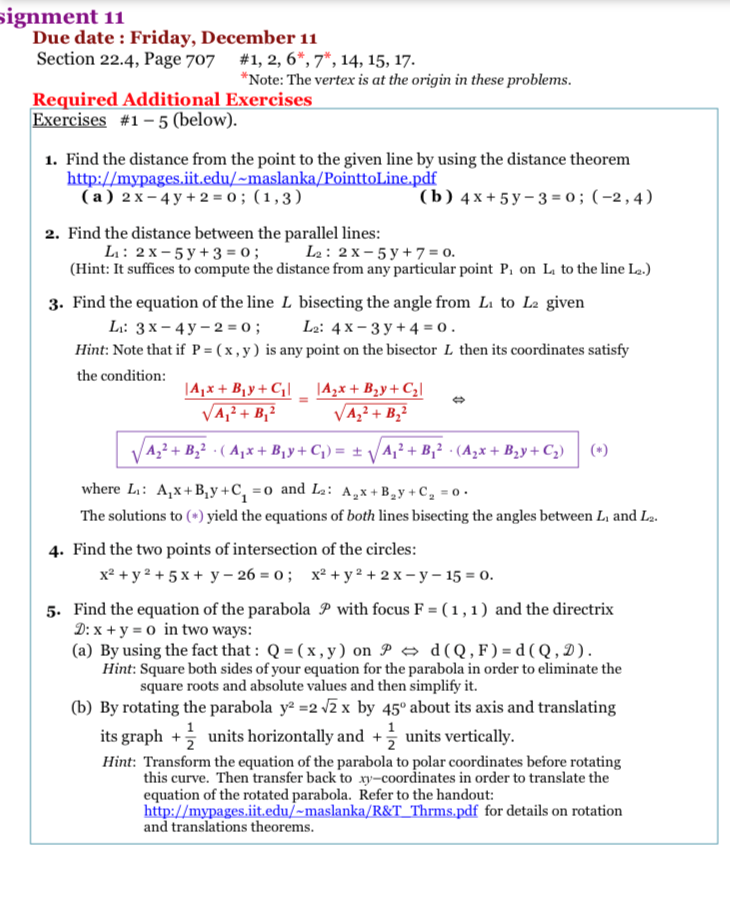Elementary Geometry For College Students, 7e
7th Edition
ISBN:9781337614085
Author:Alexander, Daniel C.; Koeberlein, Geralyn M.
Publisher:Alexander, Daniel C.; Koeberlein, Geralyn M.
Chapter4: Quadrilaterals
Section4.4: The Trapezoid
Problem 24E: The state of Nevada approximates the shape of a trapezoid with these dimensions for boundaries: 340...
Related questions
Question
Find the two points of intersection of the

Transcribed Image Text:signment 11
Due date : Friday, December 11
Section 22.4, Page 707
#1, 2, 6*, 7*, 14, 15, 17.
*Note: The vertex is at the origin in these problems.
Required Additional Exercises
Exercises #1 – 5 (below).
1. Find the distance from the point to the given line by using the distance theorem
http://mypages.iit.edu/~maslanka/PointtoLine.pdf
(a) 2 x – 4 y + 2 = 0 ; (1,3)
(b) 4х+5у-3-0; (-2,4)
2. Find the distance between the parallel lines:
L: 2 x- 5 y +3 = 0; L2: 2 x – 5 y + 7 = 0.
(Hint: It suffices to compute the distance from any particular point P, on L to the line La.)
3. Find the equation of the line L bisecting the angle from Li to La given
Li: 3 x – 4 y – 2 = 0 ;
Hint: Note that if P = ( x , y) is any point on the bisector L then its coordinates satisfy
L2: 4 x – 3 y + 4 = 0.
the condition:
|A,x + B1y+ C¡| _ |A,x + B,y+ C¿|
VA,? + B,2
VA,² + B,²
|A,² + B,² · ( Aµx + B¡y+ C;) = ± VA,² + B,² · (A,x + B2y+ C,) (*)
where L: A,x+B,y +C, =o and L2: A,x + B,y + C, = 0 .
The solutions to (*) yield the equations of both lines bisecting the angles between L, and L2.
4. Find the two points of intersection of the circles:
x² + y 2 + 5 x + y – 26 = 0 ; x² + y² + 2 x – y – 15 = 0.
5. Find the equation of the parabola P with focus F = (1,1) and the directrix
D: x + y = 0 in two ways:
(a) By using the fact that : Q = ( x , y ) on P → d(Q,F ) = d ( Q , D ).
Hint: Square both sides of your equation for the parabola in order to eliminate the
square roots and absolute values and then simplify it.
(b) By rotating the parabola y² =2 z x by 45° about its axis and translating
1
its graph + units horizontally and +; units vertically.
Hint: Transform the equation of the parabola to polar coordinates before rotating
this curve. Then transfer back to xy-coordinates in order to translate the
equation of the rotated parabola. Refer to the handout:
http://mypages.iit.edu/~maslanka/R&T_Thrms.pdf for details on rotation
and translations theorems.
Expert Solution
This question has been solved!
Explore an expertly crafted, step-by-step solution for a thorough understanding of key concepts.
This is a popular solution!
Trending now
This is a popular solution!
Step by step
Solved in 4 steps

Knowledge Booster
Learn more about
Need a deep-dive on the concept behind this application? Look no further. Learn more about this topic, geometry and related others by exploring similar questions and additional content below.Recommended textbooks for you

Elementary Geometry For College Students, 7e
Geometry
ISBN:
9781337614085
Author:
Alexander, Daniel C.; Koeberlein, Geralyn M.
Publisher:
Cengage,

Mathematics For Machine Technology
Advanced Math
ISBN:
9781337798310
Author:
Peterson, John.
Publisher:
Cengage Learning,

Algebra & Trigonometry with Analytic Geometry
Algebra
ISBN:
9781133382119
Author:
Swokowski
Publisher:
Cengage

Elementary Geometry For College Students, 7e
Geometry
ISBN:
9781337614085
Author:
Alexander, Daniel C.; Koeberlein, Geralyn M.
Publisher:
Cengage,

Mathematics For Machine Technology
Advanced Math
ISBN:
9781337798310
Author:
Peterson, John.
Publisher:
Cengage Learning,

Algebra & Trigonometry with Analytic Geometry
Algebra
ISBN:
9781133382119
Author:
Swokowski
Publisher:
Cengage

College Algebra
Algebra
ISBN:
9781305115545
Author:
James Stewart, Lothar Redlin, Saleem Watson
Publisher:
Cengage Learning